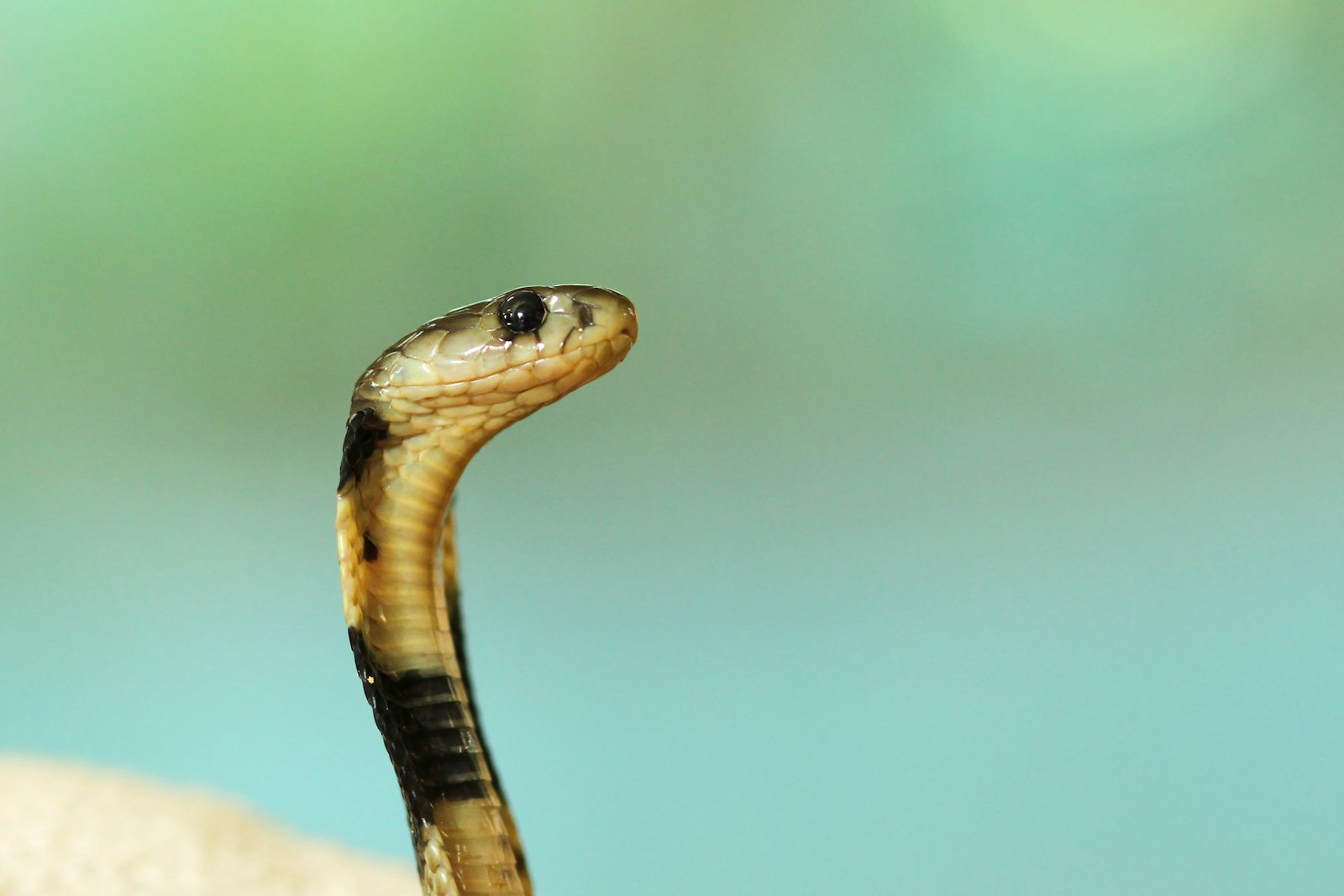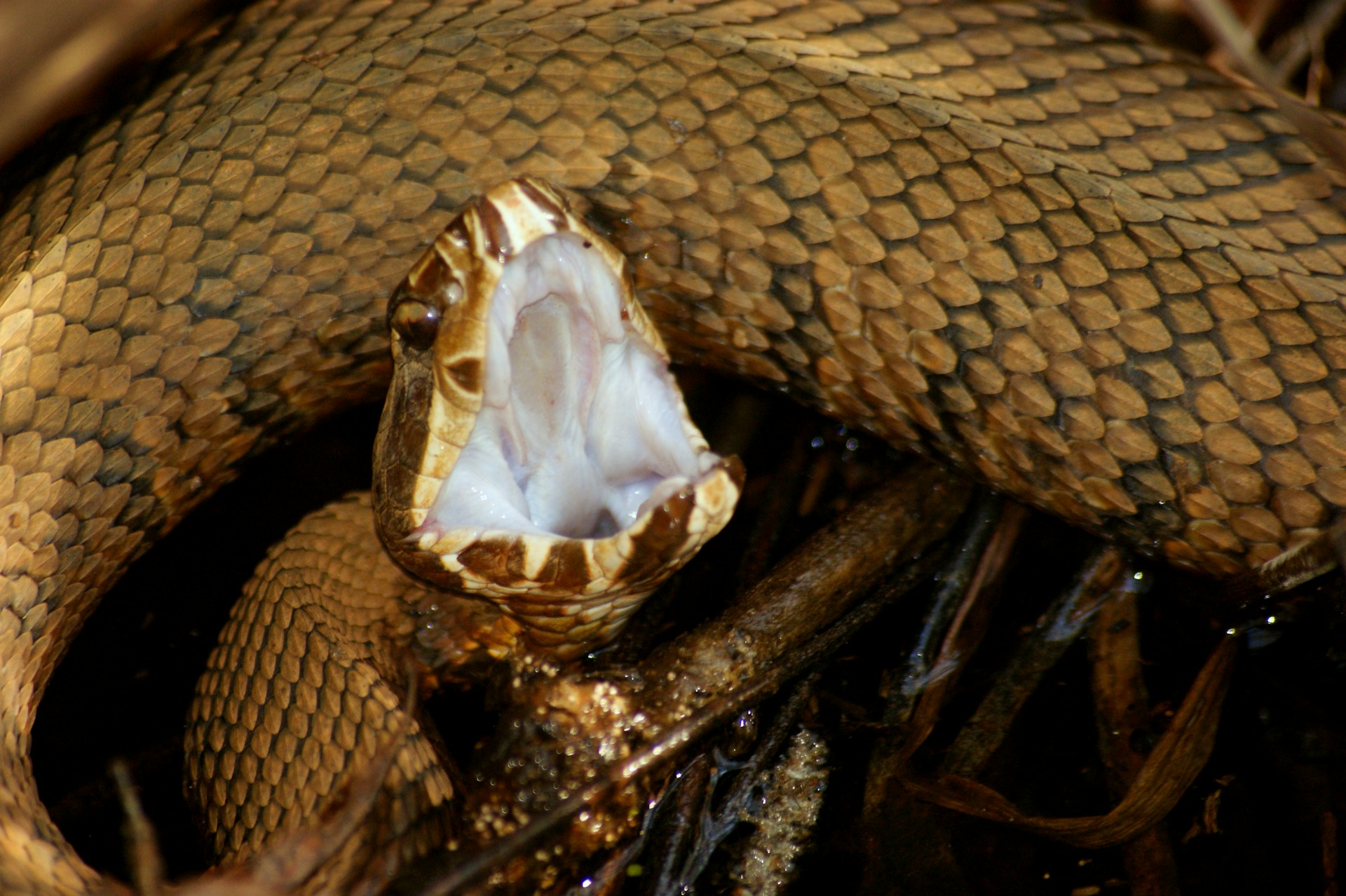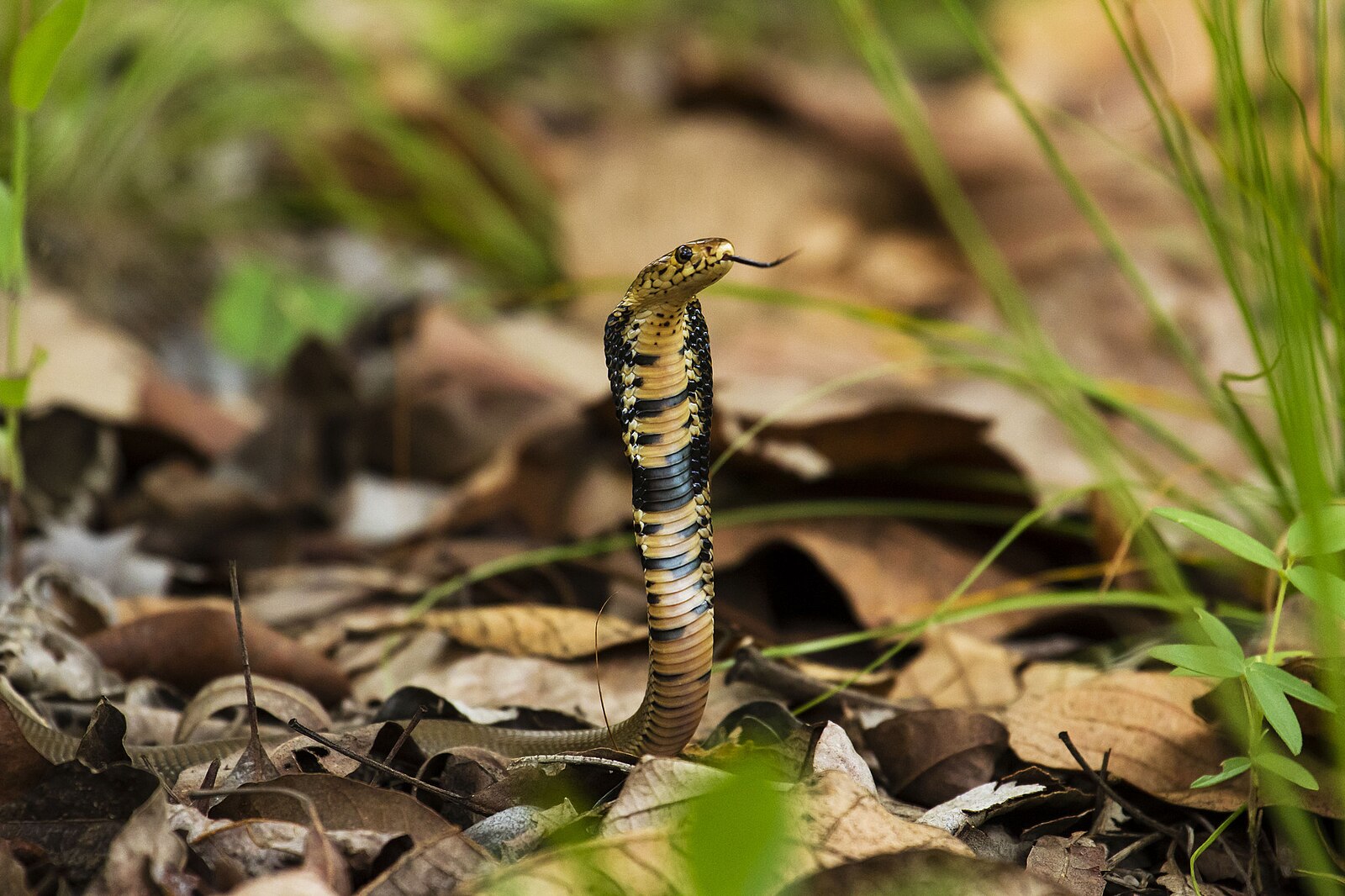When we think of venomous snakes, most people imagine relatively small, deadly creatures like cobras or rattlesnakes. However, the animal kingdom holds a startling secret – a venomous serpent of truly massive proportions. The king cobra (Ophiophagus hannah) stands alone as the world’s largest venomous snake, capable of reaching lengths exceeding 18 feet. These magnificent yet deadly reptiles command both respect and fascination, combining impressive size with potent venom in a package that has captivated scientists, conservationists, and snake enthusiasts for generations. Let’s explore this remarkable creature that defies our typical expectations of venomous snakes.
The King Cobra: An Overview
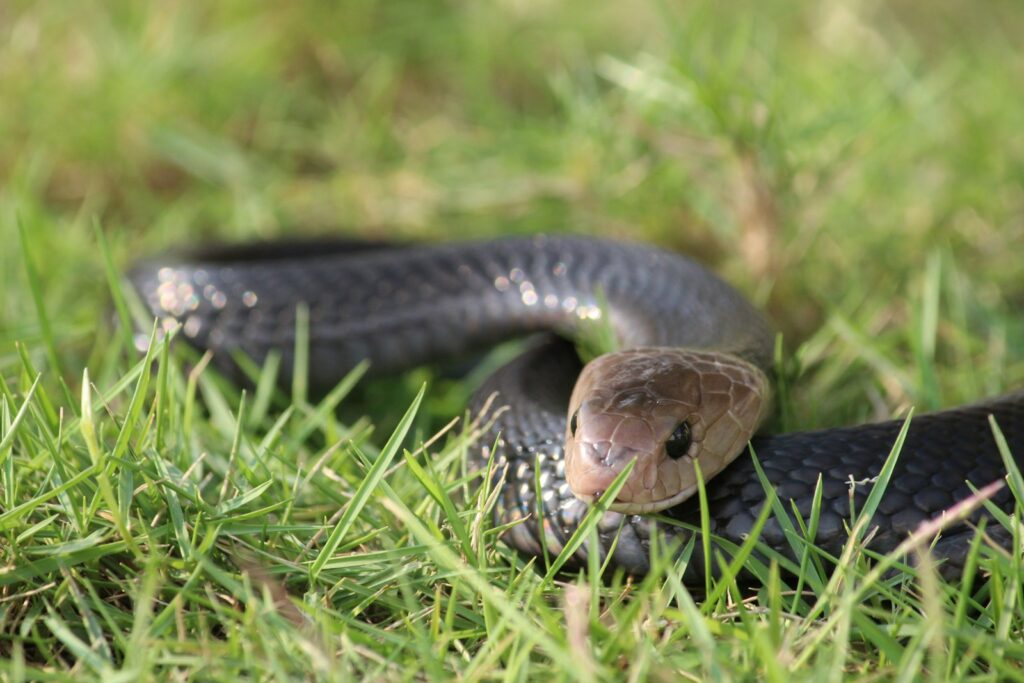
The king cobra (Ophiophagus hannah) holds the distinction of being not only the world’s largest venomous snake but also one of the most iconic serpent species on the planet. Unlike true cobras which belong to the genus Naja, the king cobra is the sole member of its genus Ophiophagus, which literally means “snake eater” – a reference to its specialized diet. These impressive reptiles are native to the forests of Southeast Asia, spanning regions from India through southern China and into the Philippines and Indonesia. With their distinctive hood, impressive length, and formidable reputation, king cobras have earned their royal title through both physical dominance and their place at the top of the snake hierarchy in their natural habitat.
Record-Breaking Dimensions
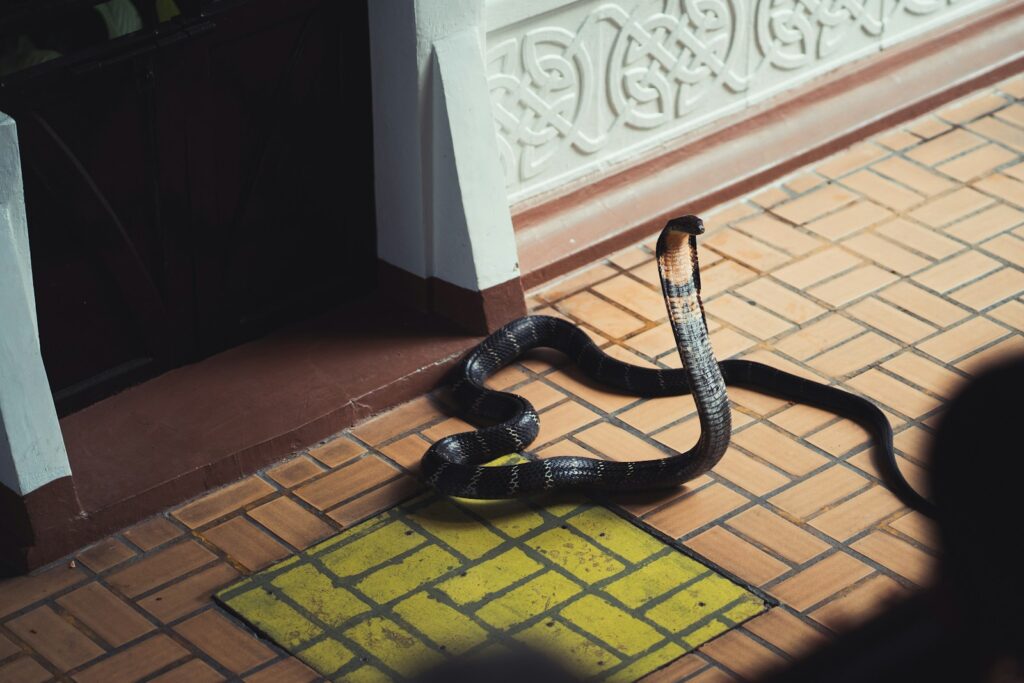
The king cobra’s size truly sets it apart from other venomous snakes, with verified specimens reaching extraordinary lengths. The longest reliably measured king cobra was 18 feet 4 inches (5.6 meters), though there are historical accounts of specimens approaching 20 feet, though these remain unverified by modern science. On average, adult king cobras typically measure between 10 and 13 feet (3-4 meters), still towering over most other venomous snake species whose average lengths rarely exceed 6 feet. In terms of weight, larger specimens can exceed 20 pounds (9 kilograms), with females generally being smaller than males – an unusual trait among snakes. This combination of length and mass makes the king cobra not just the longest venomous snake but also among the heaviest.
Distinctive Appearance and Features

King cobras possess several distinctive physical characteristics that make them immediately recognizable even among non-experts. Their most famous feature is undoubtedly the expandable hood, which forms when the snake raises the front portion of its body and spreads its neck ribs to create a dramatic, flattened display when threatened. Unlike many other cobra species, king cobras lack the distinctive spectacle or “monocled” marking on their hoods. Their coloration varies from region to region, ranging from olive-green to brown or black, often with yellowish or whitish crossbands that become more pronounced toward the tail. Adult king cobras feature sleek, glossy scales and an angular head distinct from the neck, with particularly large shields on top of their head. Perhaps most striking are their eyes – large with round pupils that give these snakes an unusually intelligent appearance compared to other reptiles.
Potent Venom and Its Effects

Despite not having the most toxic venom drop for drop, the king cobra’s venom is formidable because of the sheer quantity delivered in a single bite. Their specialized venom glands can produce and deliver up to 7 milliliters (about 1.5 teaspoons) of venom in a single bite – enough to kill 20-30 adult humans or even an elephant. King cobra venom is primarily neurotoxic, attacking the victim’s central nervous system and causing symptoms including pain, dizziness, and blurred vision, progressing to respiratory failure and eventually death if untreated. The mortality rate from untreated king cobra bites ranges from 50-60%, with death potentially occurring as quickly as 30 minutes after envenomation, though typically taking several hours. Interestingly, the venom composition of king cobras differs from other cobras, containing unique toxins specifically evolved to subdue other snake species, which make up a significant portion of their diet.
Habitat and Geographic Distribution
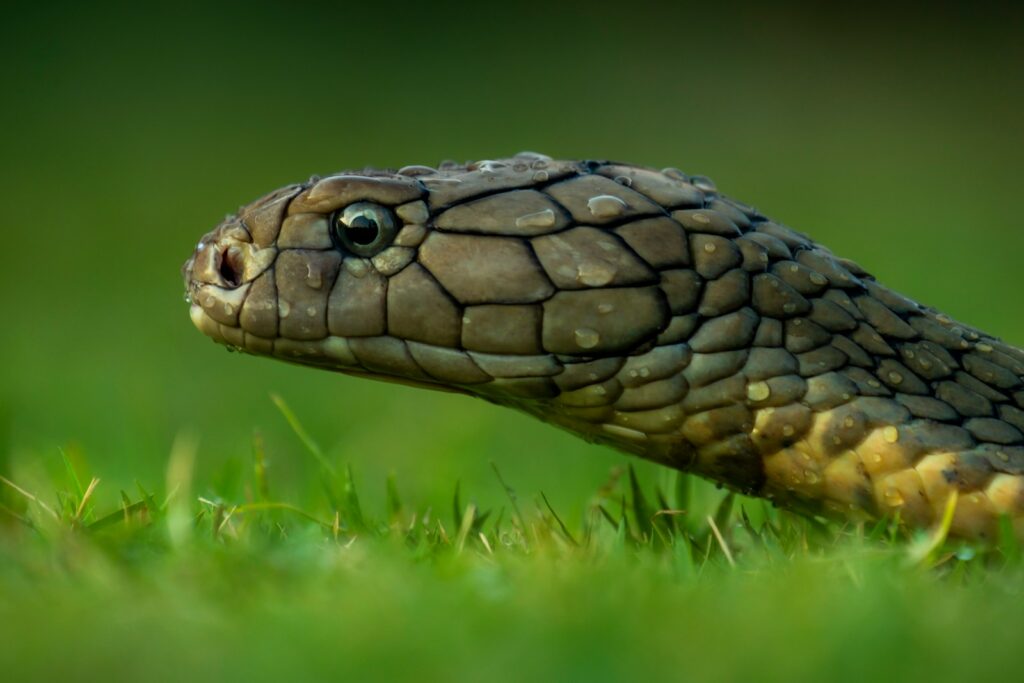
King cobras inhabit a diverse range of forested habitats across South and Southeast Asia, displaying remarkable adaptability to different environments. Their range extends from western India eastward through southern China and into the Philippines and Indonesia, encompassing countries including Bangladesh, Bhutan, Myanmar, Thailand, Laos, Cambodia, Vietnam, and Malaysia. These massive serpents show a preference for high-humidity environments, particularly favoring dense rainforests, bamboo thickets, and mangrove swamps where prey is abundant. They’re also found in agricultural areas adjacent to forests, particularly plantations where small mammals and other snakes may be plentiful. Unlike many snake species, king cobras can thrive across a range of elevations, from lowland forests near sea level to mountainous regions up to 2,000 meters (6,500 feet) in altitude, though they become less common at higher elevations where cooler temperatures prevail.
Hunting and Dietary Specialization
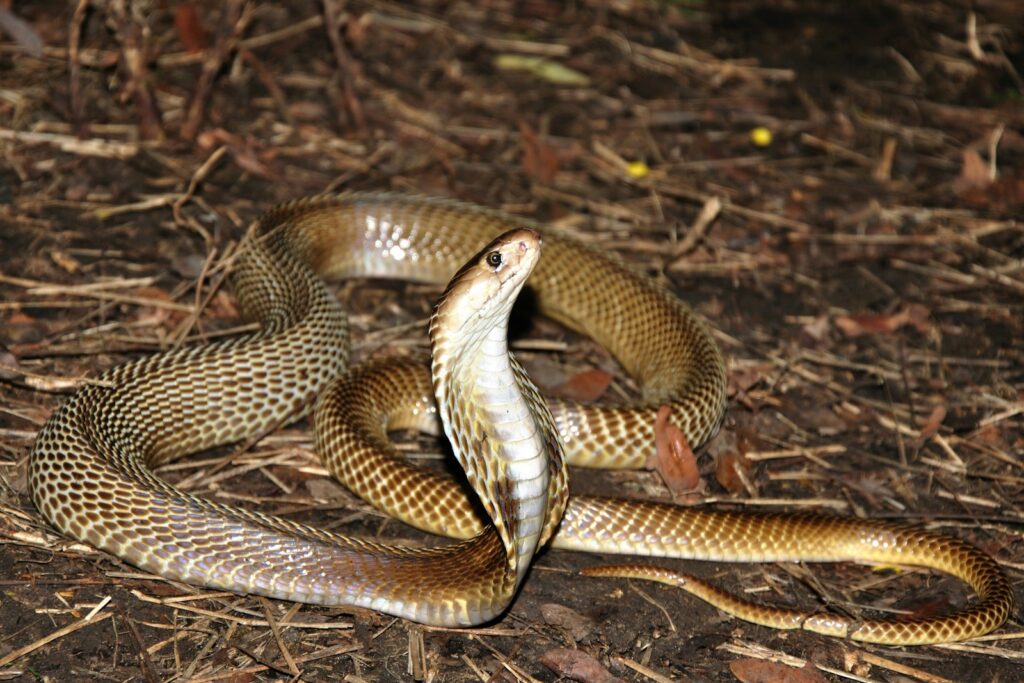
The king cobra possesses perhaps the most specialized diet of any snake species, earning its scientific name Ophiophagus (“snake-eater”) through its strong preference for other snakes. Approximately 70% of a wild king cobra’s diet consists of other snake species, including venomous varieties like kraits and even smaller cobras. They also prey on monitor lizards, with mammals representing only a small portion of their natural diet. When hunting, king cobras combine excellent vision with a keen sense of smell, actively pursuing prey rather than ambushing like many other snake species. Their hunting technique is distinctive – they use their size advantage to overpower prey, delivering a precise bite often to the back of the head before holding on until the venom takes effect. Capable of swallowing prey up to a quarter of their own body length, king cobras have been documented consuming python species nearly as large as themselves, truly earning their position as apex predators in the snake world.
Unique Reproductive Behavior
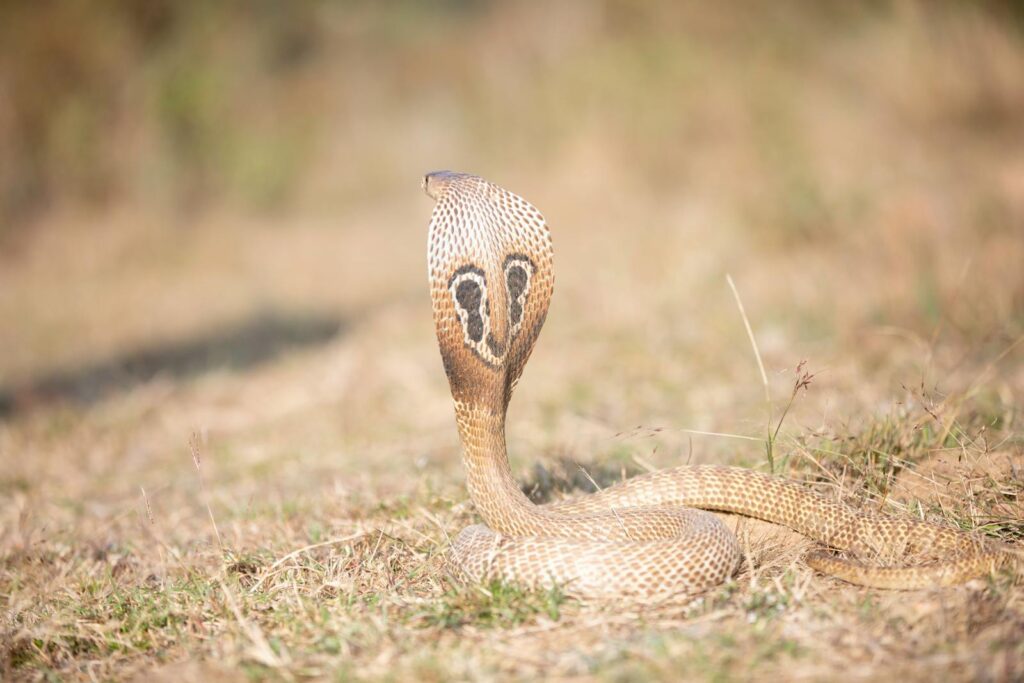
King cobras display reproductive behaviors that set them apart from virtually all other snake species, most notably their nest-building habit. They are the only snake species known to construct nests for their eggs, with females gathering leaves, twigs, and other plant material into mounds that can measure up to 3 feet high and 5 feet across. After constructing this nest, the female lays 20-40 eggs inside and remains with them throughout the approximately 70-day incubation period, demonstrating a rare form of parental care among reptiles. During this guarding phase, the female becomes extremely aggressive, attacking any potential threats that approach the nest. Interestingly, just before the eggs hatch, the female abandons the nest permanently, presumably to avoid any temptation to eat her own offspring. Hatchlings emerge at an impressive 18-22 inches (45-55 cm) in length, already equipped with fully functional venom glands and instinctively capable of raising their hoods and delivering defensive strikes.
Intelligence and Behavior
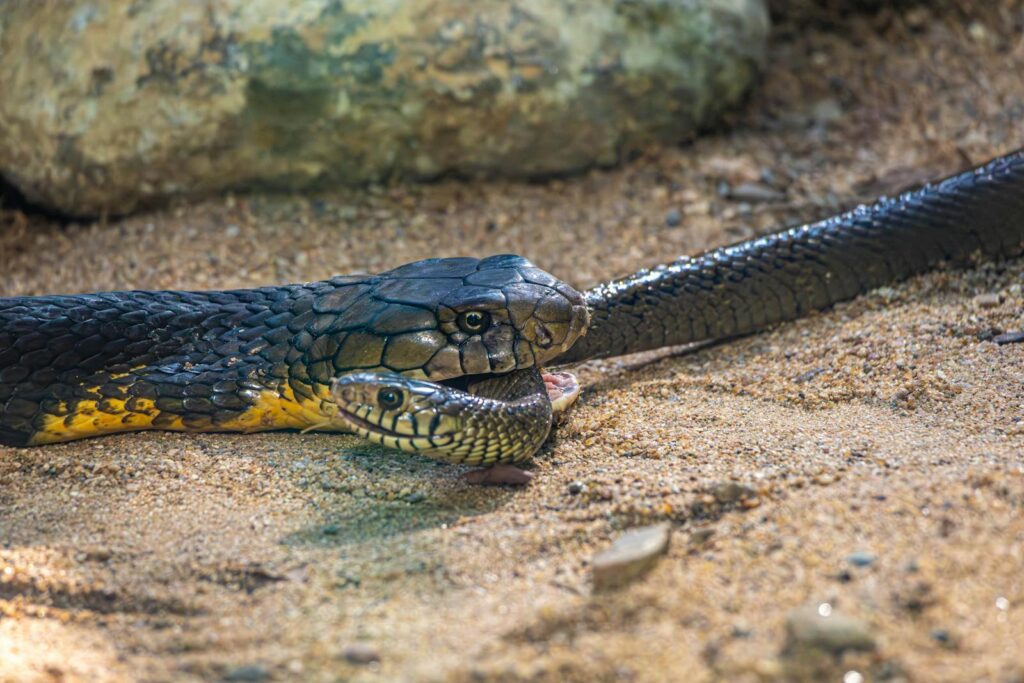
Among reptiles, king cobras demonstrate remarkable cognitive abilities that have impressed researchers and handlers alike. They show evidence of problem-solving capabilities and spatial awareness beyond what is typically associated with reptiles, including an apparent ability to recognize individual humans over time. When confronted, king cobras display a complex series of warning behaviors before resorting to striking, including raising their head and upper body to impressive heights (up to one-third of their total length), extending their hood, and producing a distinctive hiss that sounds more like a growl. Unlike many aggressive snake species, king cobras generally prefer to avoid confrontation when possible, often retreating when given the opportunity. Particularly interesting is their demonstrated capacity for learned behavior – captive specimens have been observed adapting their responses based on previous interactions, suggesting a level of behavioral plasticity uncommon in the reptile world.
Conservation Status and Threats
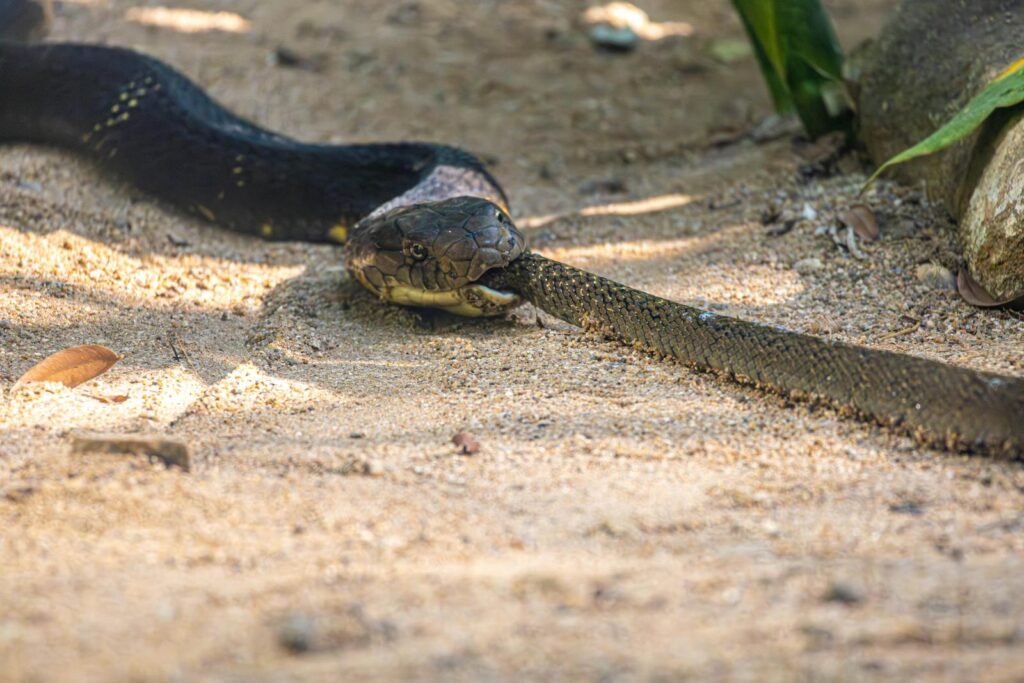
The king cobra is currently classified as “Vulnerable” on the IUCN Red List, with populations experiencing significant declines across much of their range. Habitat destruction represents the most severe threat, with deforestation for agriculture, logging, and development eliminating the dense forest ecosystems these snakes require. Wildlife trafficking presents another serious concern, with king cobras captured for the exotic pet trade, traditional medicine, and even consumption in some regions. Climate change poses an emerging threat, as alterations in temperature and precipitation patterns may disrupt the king cobra’s highly specialized ecological niche. Additionally, indiscriminate killing due to human fear remains widespread – despite their generally shy nature, king cobras are often killed on sight due to their dangerous reputation. Conservation efforts face the challenge of protecting a species that, despite its ecological importance, inspires fear rather than the public sympathy generated by more charismatic endangered species.
Ecological Importance
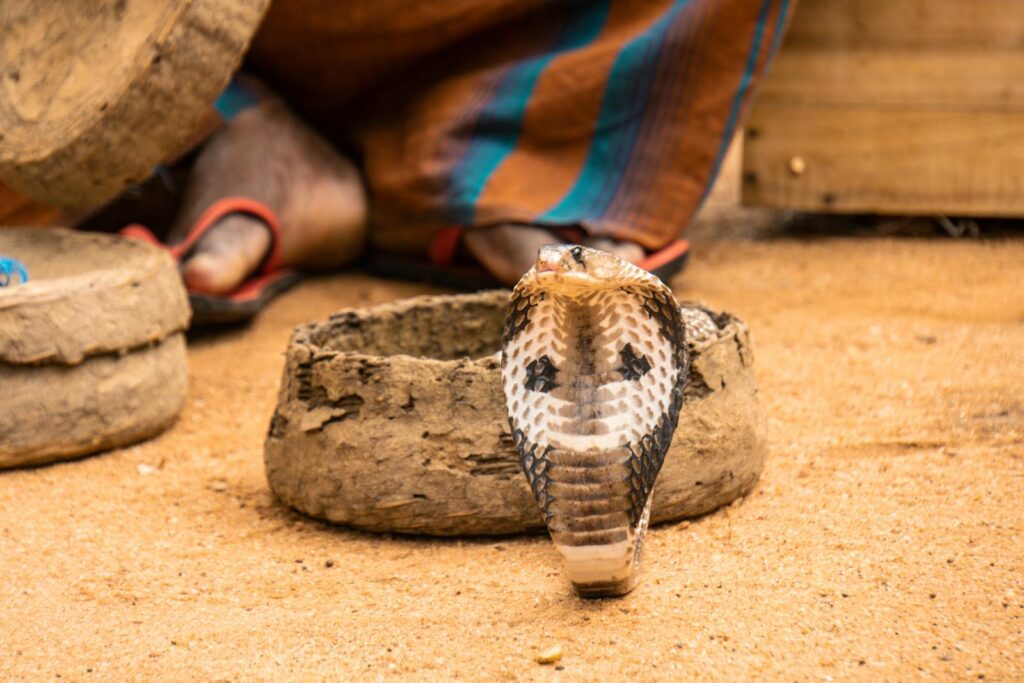
Despite their fearsome reputation, king cobras perform vital ecological functions within their native habitats. As apex predators specializing in consuming other snake species, they help regulate the populations of both venomous and non-venomous snakes, preventing any single species from becoming too abundant. This predatory role extends to controlling rat snake populations, which in turn impacts rodent numbers, creating a cascade effect throughout the food web. King cobras also serve as indicators of ecosystem health – their presence typically signals an intact and functioning forest ecosystem with sufficient diversity to support specialized predators. Additionally, their nesting behavior contributes to forest floor ecology, as their large nest mounds decompose over time, recycling nutrients and creating microhabitats for smaller organisms. Conservation biologists often cite the king cobra as a prime example of why even feared predators deserve protection, as their removal can trigger unpredictable consequences throughout entire ecosystems.
Cultural Significance
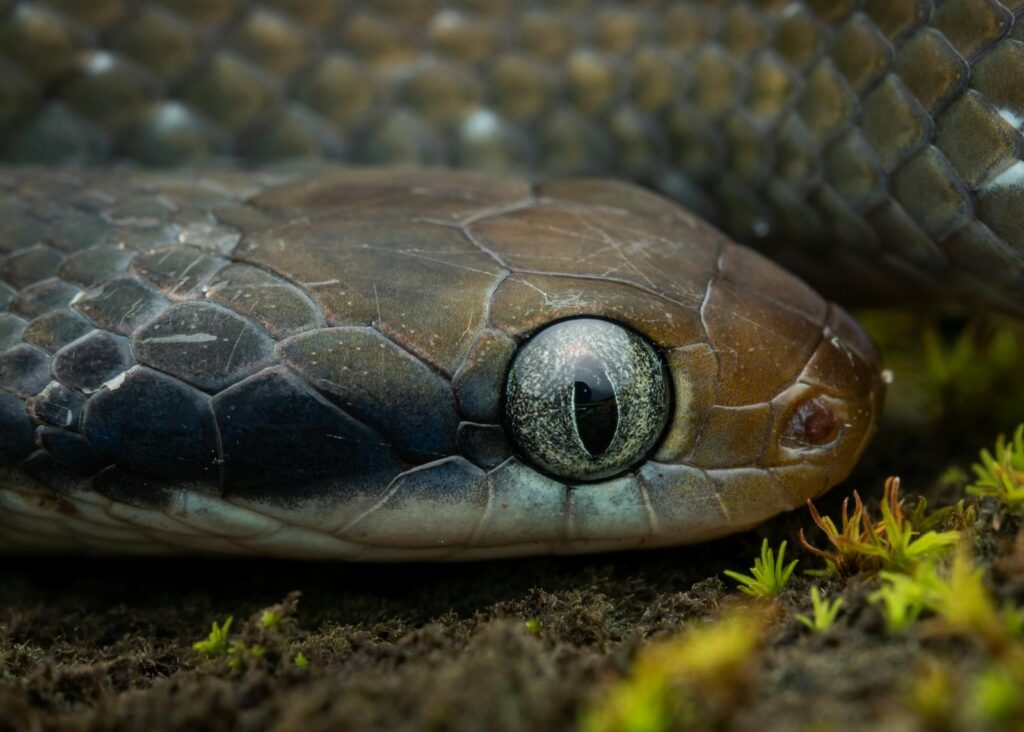
Throughout their range, king cobras have achieved profound cultural significance, often appearing in religious iconography, folklore, and national identities. In Hindu mythology, the divine serpent Shesha, often depicted as a massive cobra, supports Lord Vishnu as he dreams the universe into existence, while many temples feature cobra imagery as guardians of sacred spaces. Thai culture particularly venerates the king cobra, featuring the snake in numerous ceremonies and as the namesake for their national kickboxing style, Muay Thai (literally “cobra boxing”). Traditional medicine systems across Asia have incorporated king cobra parts for centuries, with venom, meat, and organs prescribed for ailments ranging from joint pain to sexual dysfunction. Even in contemporary global culture, the king cobra has become an emblem of deadly precision and power, appearing in logos, military unit insignia, and as a frequent character in wildlife documentaries, where its impressive hood-spreading display remains one of the most recognized animal behaviors worldwide.
Research and Venom Benefits
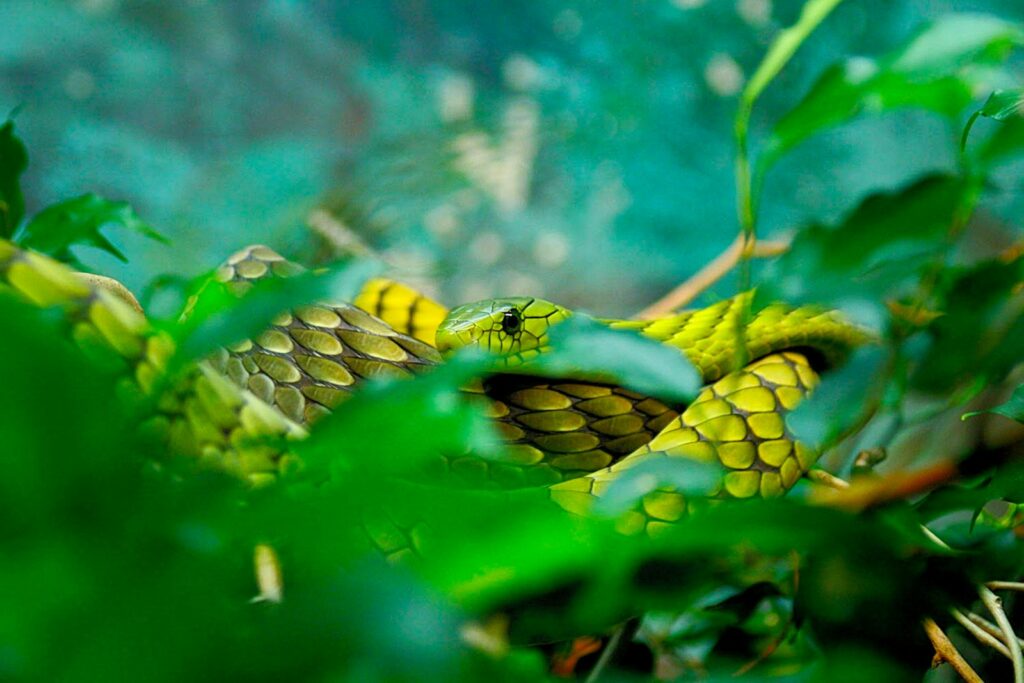
Scientific interest in king cobras extends beyond herpetology into pharmacology and medical research, where their venom components offer promising therapeutic applications. Researchers have identified several unique proteins in king cobra venom with potential medical value, including components being investigated for pain management that could potentially replace opioid medications. Ophiophagus hannah toxins are also being studied for applications in treating neurodegenerative conditions like Alzheimer’s disease, where certain venom components show potential to target disease mechanisms. Cardiovascular research represents another frontier, with king cobra venom yielding compounds that may help develop treatments for hypertension and other circulatory disorders. Beyond direct medical applications, studying how king cobras produce and resist their own potent venom provides insights into evolutionary biology and protein biochemistry, exemplifying how even the world’s most dangerous creatures may ultimately contribute to human welfare through scientific understanding.
Encounters and Safety

Despite their intimidating size and potent venom, king cobra attacks on humans remain relatively rare, primarily because these snakes typically avoid human contact whenever possible. When encounters do occur, they often result from accidental disturbance of the snake, particularly near nesting sites where females display heightened aggression. Wildlife experts recommend specific protocols if a king cobra is encountered in the wild: maintain distance (at least 20 feet), avoid sudden movements, and back away slowly without turning your back on the snake. Most fatalities from king cobra bites occur in rural areas with limited access to medical care, as effective antivenoms exist but must be administered promptly. Professional snake handlers who work with king cobras emphasize their predictability compared to other venomous species – while extremely dangerous, king cobras typically provide clear warning displays before striking, rarely acting with the impulsive aggression seen in species like black mambas or certain vipers.
conclusion

The king cobra stands as a remarkable example of evolutionary specialization – a creature that has developed not only extraordinary size but also complex behaviors, ecological adaptations, and cultural significance throughout its range. While its length and venomous capability make it one of the world’s most formidable predators, the species faces mounting challenges from habitat loss and human persecution. As we continue to learn more about these magnificent serpents, the importance of their conservation becomes increasingly clear. The king cobra reminds us that even creatures that inspire fear deserve our respect and protection, representing an irreplaceable component of tropical forest ecosystems. In their combination of size, power, and ecological importance, these 18-foot giants truly earn their royal title as kings among snakes.

